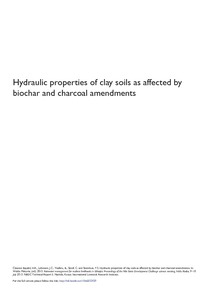Resource information
Understanding soil hydraulic properties is crucial for planning effective soil and water management practices. A study was conducted to evaluate the effects of different biochar and charcoal treatments on soil-hydraulic properties of agricultural soils. Biochar and charcoal treatments were applied on 54, undisturbed soil-columns, extracted from three-elevation ranges, with replications along three transects. Daily weight losses of freely draining soil-columns and soil moisture contents, at five tensions, were measured. In addition, field infiltration tests and soil analyses for particle size distribution, bulk-density and organic carbon content were conducted. Moreover, five year event precipitation data, from the watershed, was analysed and exceedance probability of rainfall intensity was computed. Results show treatments reduced soil moisture contents, for most of the cases. However, treatment effects were significant only at lower tensions (10 and 30 kPa) and within two days after saturation (p<0.05). On the other hand, relative hydraulic conductivity (Kr) coefficients, near saturation, of amended soils were higher than the control. Acidic to moderately acidic soils with high average clay (42%) and low organic carbon contents (1.1%) were dominant. Infiltration rate ranged between 1.9 and 36 mm/h, with high variability (CV = 70%). At the same time, storms with short duration (< 15 min) and high average intensity (6.3 mm/h) contributed for 68% of annual precipitation (1616mm/year). Dominant soil properties and rainfall characteristics suggest that infiltration could be a major problem on considerable number of fields, in the watershed. This implies, on such fields, constructing physical soil and water conservation structures alone will not reduce runoff and erosion effectively, unless soil infiltration and permeability rates are enhanced through integrated soil management approaches.?



